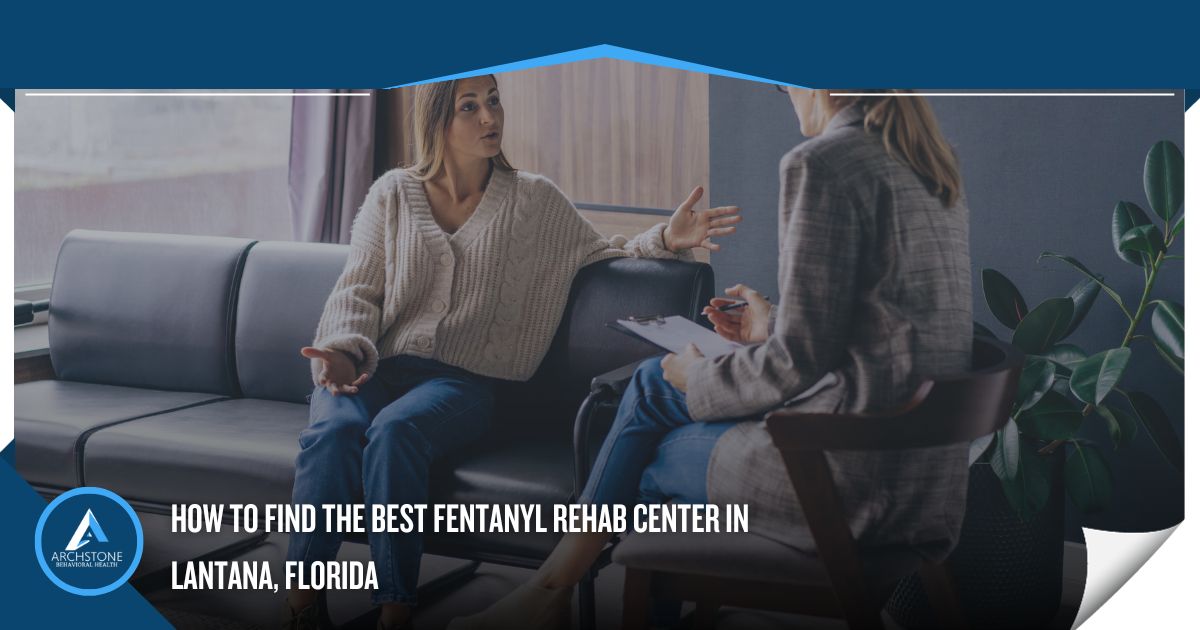How to Find the Best Fentanyl Rehab Center in Lantana, FL
Get Help Now

According to the National Institute on Drug Abuse (NIDA), “deaths involving synthetic opioids other than methadone (primarily fentanyl) continued to rise with 70,601 overdose deaths reported in 2021.”[1]
If you or a loved one are addicted to fentanyl, it’s time to consider professional treatment. Once you’ve decided to enter rehab, you must find a program that is best suited to your needs. This can be difficult, especially if you’ve never attended treatment before.
Thankfully, there are ways to determine which fentanyl rehab centers in Lantana, FL are reputable and effective.
How to Tell it’s Time for Fentanyl Addiction Treatment in Lantana, FL
If you are abusing fentanyl, you are more than likely addicted because of the way it affects the pleasure and reward system in your brain. The more you abuse fentanyl, the more your brain will crave it and begin to rely on it to function properly.
Leaving fentanyl addiction untreated can lead to multiple life-threatening overdoses. Unfortunately, many people who overdose on fentanyl require immediate medical attention to survive.
If you relate to the following symptoms, it’s time to look for fentanyl addiction treatment in Lantana, FL:
- Spending a lot of time thinking about or using fentanyl
- Using fentanyl to get high instead of as directed by a doctor
- Buying fentanyl from drug dealers rather than a pharmacy
- Experiencing strong urges or cravings to abuse fentanyl
- Losing interest in previously enjoyed activities
- Isolating from friends or loved ones
- Failing to complete responsibilities because of fentanyl use
- Needing a higher dose of fentanyl to experience the desired effect
- Experiencing withdrawal symptoms when you can not abuse fentanyl
- Dealing with repeated fentanyl overdoses and continuing to abuse the substance
What to Look for in a Fentanyl Rehab Program in Florida
If you or a loved one require fentanyl addiction treatment, it can be difficult to determine which program to attend. Being aware of what qualities make a fentanyl rehab program effective can help you choose the best one.
To find the best fentanyl rehab center in Lantana, FL, look for the following services:
Medication-Assisted Treatment (MAT)
The first thing you should look for in a fentanyl addiction treatment program is medication-assisted treatment (MAT). This type of treatment involves the use of medications to limit withdrawal symptoms and decrease cravings, lessening your chances of relapse.
According to the Substance Abuse and Mental Health Services Administration (SAMHSA), MAT provides the following benefits:[2]
- Improved patient survival
- Increased retention in treatment
- Decreased illicit opiate use and other criminal activity among people with substance use disorders
- Increased patient ability to gain and maintain employment
- Improved birth outcomes among women who have substance use disorders and are pregnant
Evidence-Based Therapies
The next quality you should look for is evidence-based therapies. This means that a fentanyl rehab center is using therapies that are proven effective in treating addiction.
Examples of evidence-based therapies for addiction used in Florida fentanyl rehab programs include:[3]
- Cognitive behavioral therapy (CBT)
- Motivational interviewing (MI)
- Contingency management (CM)
- 12-step facilitation therapy
- The matrix model
- Family behavior therapy
Holistic Services
Reputable fentanyl addiction treatment programs in Lantana, FL include holistic services in their treatment plans. Holistic treatment focuses on healing the “whole person”, which means you will recover emotionally, behaviorally, physically, and spiritually.
Examples of holistic treatments used during fentanyl rehab in Lantana, FL include:
- Yoga and meditation
- Massage therapy
- Mindfulness techniques
- Breathing exercises
- Art and music therapy
- Nutritional counseling
- Adventure therapy
Relapse Prevention Planning
Lastly, you should always choose a fentanyl rehab program in Lantana, FL that provides relapse prevention planning. This recovery technique provides you with the tools, support, and services you need to maintain sobriety outside of rehab.
Examples of services used in a relapse prevention plan include:
- Continued attendance at therapy
- Continued medication management
- Access to alumni support groups
- Case management services like vocational and legal assistance
- Recommendations on local recovery support groups like 12-step meetings
- Referrals to sober living housing programs
- A list of triggers and coping mechanisms that work for you
Get Connected to a Highly Rated Fentanyl Rehab Center in Lantana, FL
If you or a loved one struggles with fentanyl addiction in Florida, it’s time to seek help. At Archstone Behavioral Health, we can provide you with state-of-the-art addiction treatment services to ensure you have the best shot at long-term recovery possible.
To learn more about our fentanyl rehab center in Lantana, FL, contact us today.
References:
- The National Institute of Drug Abuse (NIDA): Drug Overdose Death Rates, Retrieved August 2023 From https://nida.nih.gov/research-topics/trends-statistics/overdose-death-rates
- The Substance Abuse and Mental Health Services Administration (SAMHSA): Medications for Substance Use Disorders, Retrieved August 2023 From https://www.samhsa.gov/medications-substance-use-disorders
The National Library of Medicine (NLM): Evidence-based practices for substance use disorders, Retrieved August 2023 From https://www.ncbi.nlm.nih.gov/pmc/articles/PMC3678283/